#example: star wars' republic's age
Text
Sometimes folks get so wrapped up in the minutiae of plot, the fake logic that holds a story together, that they lose sight of theme.
Like all rules of artistic expression, the rules we impose on our fictional worlds are there to be altered to service a thematic purpose or message.
#lyle's musings#writing thoughts#example: northern water tribe sexism#it only exists for one episode to show how awesome katara is (also how lame sexism is)#until I went out into the wider fandom I thought we all knew that it was just one guy being a prick#and imposing his personal biases onto society via his position of power and authority#example: star wars' republic's age#we have multiple interviews with GL that explicitly state the republic is 1000 years old as of the prequels#bu the fandom is pushing out constant fucking retcons to make plot points square with previous retcons of retcons#all in service of literalizing a line that was more about emphatic longevity than timekeeping
0 notes
Text
What "The Hidden Fortress" (1958) tells us about the Jedi's status in the Prequels.
In 1999, George Lucas had this to say on BBC Omnibus: A Long Time Ago: The Story of "Star Wars" and then The Phantom Menace's director's commentary.
“I greatly admired Kurosawa, especially the film Hidden Fortress, which told a story from the point of view of two serfs, two slaves...

... peasants who tag along with this famous general and a princess-- y'know, royalty. And the whole story is told from their point of view. And I like that idea.
I like the idea of telling a story from the lowest person's point of view, uh, in the food chain, and that's how the story got to be told by Artoo and Threepio.”
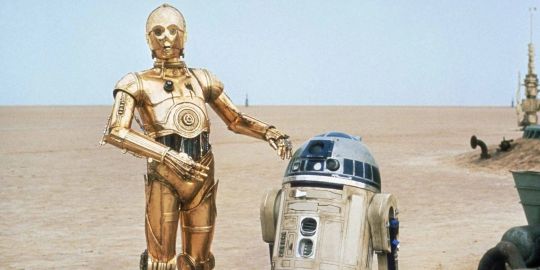
“[The Phantom Menace] is told primarily from the Jedi's point of view, but the story that's being told is essentially the story of Queen Amidala and her plight of having her planet blockaded. As in, say, Episode IV, where the story is told through the eyes of the droids, in this one, it's told through the eyes of the Jedi.”
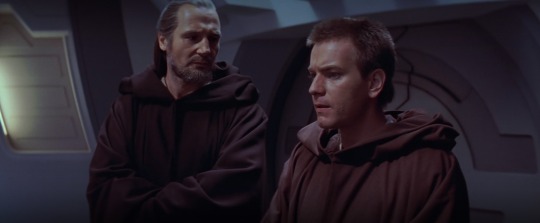
“But [from the moment we get to Coruscant, Anakin and Jar Jar] are standing on the sidelines. It's a little bit a riff on the very first film where the story is told through the point of view of the droids, who were sort of the lowliest characters.”

“And in [Phantom Menace], I'm doing it through - primarily - the two Jedi, but then the secondary characters are also carrying a lot of the weight when the Jedi aren't around.”
George Lucas draws a comparison between lowly characters like Hidden Fortress' peasants Matashichi and Tahei, the droids in A New Hope, as well as the Jedi in The Phantom Menace.
What do they all have in common? They are all the lowest-ranking characters in their respective films. Repeat: the movie frames the Jedi as almost at the bottom of the food chain.
Because of course they are. Functionally, they're just diplomats. They hold no political power whatsoever and barely have any authority .
What little authority the Jedi do have in TPM comes from the Queen's young age, which allows them to ease into a more advisory position, and Qui-Gon's rebellious streak. And even he's explicit about the fact that his mandate has limitations.

The only characters "below" them in status are Jar Jar, an exiled Gungan, and Anakin, who just yesterday was still a slave kid, Artoo the literal object and that's it!
Also the other Prequel films are consistent with this portrayal. Who do we see lower in status than the Jedi? Dexxter Jettster and the clones. Everyone else is pretty much above them.
Yes, the Jedi are part of the system, but they're not as high-ranking as you'd think. Yes, they have Force Powers, but that means squat when put against political power. So, like, to expect the Jedi to...
influence the decisions of the Senate,
wage a war against the Outer Rim to end slavery,
or blatantly refuse an order to join the war effort,
... is incredibly unreasonable.
They're not meant to be seen as "the elite, peering down upon the people from their ivory tower".
They're the servants! Servants of the Republic.
And they're seeing their higher-ups destroy what they should all stand for, but are unable to stop them.
Later on, with The Clone Wars, we are introduced to civilian characters and from their point of view, the Jedi are ultra powerful and are highly placed and "should do more but don't".
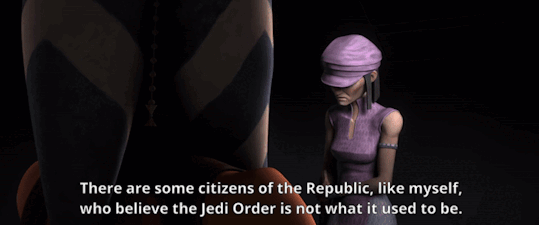
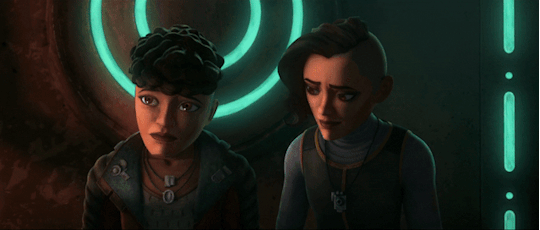
It makes sense that these characters would see the Jedi as 'the elite'. But they don't have the full picture.
We, as the audience, do.
So we know that the reality is more along the lines of the Jedi "should do more but can't".
After all, we are made privy many instances of the Jedi speaking up and trying to change politicians' minds, only to be dismissed and overruled at every turn.
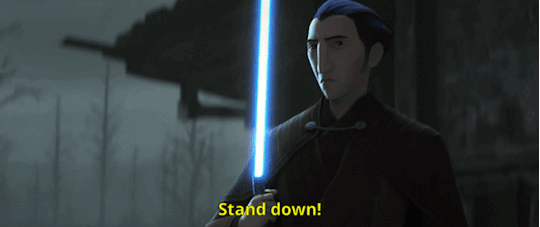
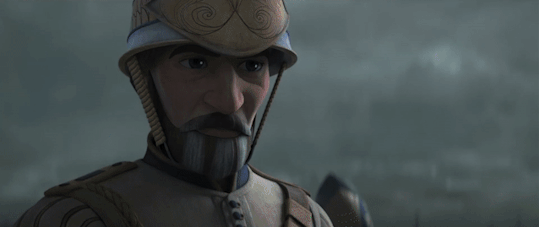




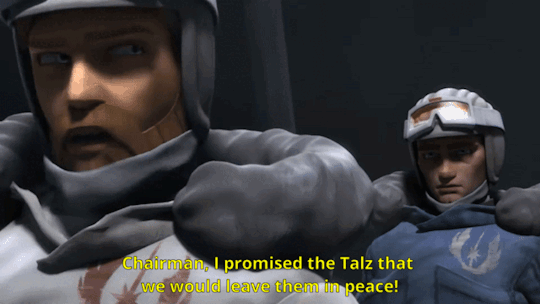
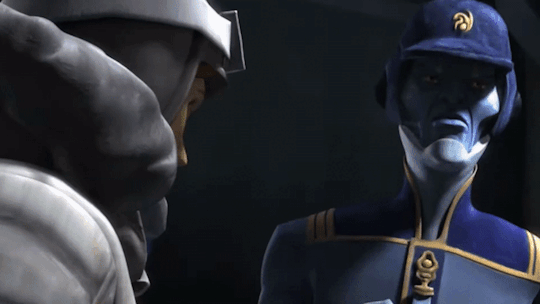

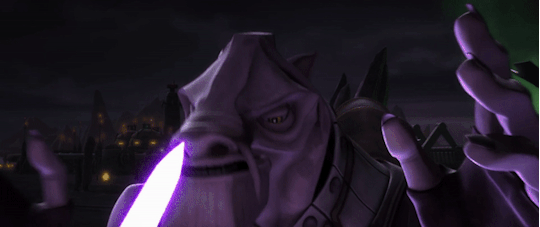
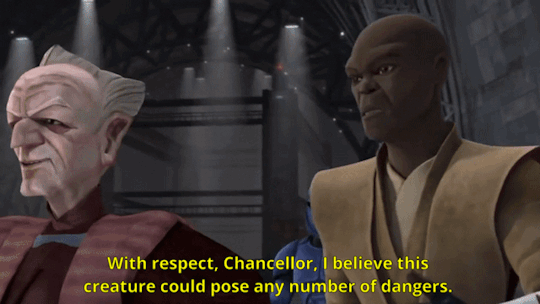
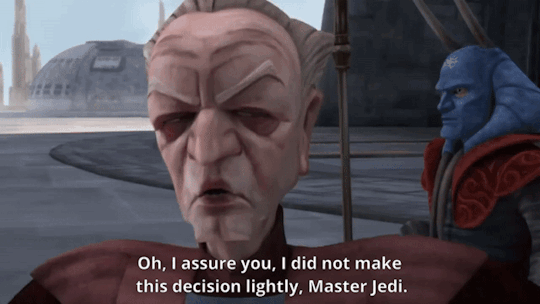


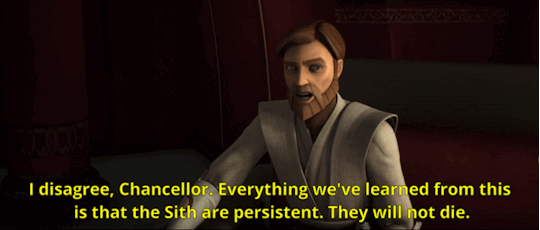

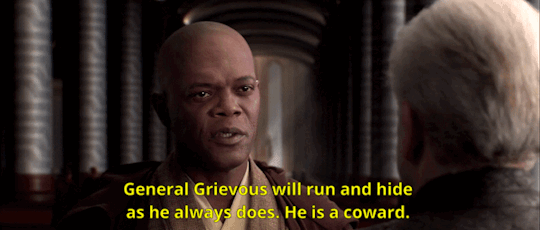
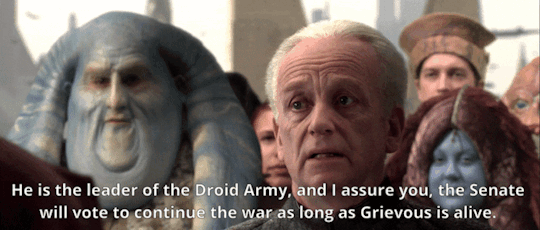
↑ these aren't even all the times we see it happen, btw, there's more examples...
So at some point, if you - as an audience member - see all this and are still saying "the Jedi should've done more!" I really need to know... what more could they have done?
Take control of the Senate?

That'll result in a dictatorship, there's a reason they waited as much as they did before trying to take down Palpatine.
Power corrupts and they're wise enough to know it.
Don't join the Republic in the first place?
George Lucas never frames the Jedi's involvement with the Republic as a bad thing. In the foreword to Shatterpoint (2004), he says their being part of the Republic led to 1,000 years of prosperity.
Where's the issue, then? Well, it's a two-man job and the Jedi's bosses, the Senate, grew corrupt and stopped doing their part. They stopped carrying their end of the couch.
But “no Jedi in the Republic from the get-go” means the Sith will rise to power even faster. Fun!
Stay neutral in the war?
The Separatists were killing civilians and testing weapons on neutral systems, or enslaving them.


The choice put before the Jedi was "do what we tell you and fight, or let people die".
But also, out-of-universe... do you really think Palpatine, genius politician, master of spin, can't re-frame the Jedi staying neutral in a negative light?
When they joined the war, he unleashed propaganda that either directly (on the Separatist side) or indirectly (on the Republic side) framed them as "warmongers who corrupted their values". If they don't join, they're "apathetic cowards who care more about their own values than the lives of the people they're supposed to protect".
So either way, Order 66 comes around, wipes them out and the Republic goes "good riddance".

So what else could they do?
The answer is "not much".
Because the whole point of the narrative is that Palpatine checkmated them by taking the fight to a field the Jedi had no experience in or right to meddle with: politics.
So if you look at these characters who are nowhere near the top of the food chain, and say "well, why didn't they fix things?" I'm sorry to say you're missing the point of the narrative.
Or maybe you do get the point of the narrative and just aren't trying to be fair...

... in which case, at least be consistent and also argue:
"Why didn't Threepio & Artoo do more to save the Rebel crew of the Tantive IV from the stormtrooopers?!"
"Why didn't Matashichi & Tahei do more to save the Akizuki clan?!"
#HINT: the answer to both those rhetorical questions is “there was nothing they could do”#Also while we're on 'Hidden Fortress' - it's also worth pointing out that Qui-Gon and Padmé's dynamic on Tatooine in TPM#is very similar to the dynamic of General Rokurota and Princess Yuki in 'Hidden Fortress'.#The older warrior looking after the royalty teenage girl who is dressed as a peasant so as to not draw attention because she's on the run.#The Hidden Fortress#Akira Kurosawa#George Lucas#Artoo#Threepio#c3po#r2d2#lucas quotes#meta#on the jedi's involvement in the clone wars#in defense of the jedi#jedi order#qui-gon jinn#the phantom menace#star wars#long post
836 notes
·
View notes
Note
hiya! long time listener, first time caller-- I'm writing a couple fics with Jedi protagonists (Shaak Ti, Mace, other Prequel Jedi) which is really fun so far except for the part where I "majored in" (read: hyperfixated on) Organization and Tactics of the GAR and don't actually know that much about the Jedi as individuals, *especially* anything that happened before TPM.
I was wondering if you know of any resources that organize/compile information about that era of Jedi? Things like lineage lists, who was on the Council when, typical schedules/roles/responsibilities, that kinda thing. Resources can be any format; other Tumblr blogs, articles, images, discord servers, archived websites, whatever works! Even the obvious stuff can be helpful (outside of Wookiepedia), since this isn't a part of fandom I've walked through much. You're the only big-name Jedi blog I know.
(If you don't have the spoons to respond, I understand, thanks for reading anyway!)
Hi! Congrats on writing your fic, I'm wishing you all the luck in the world! And here's where my brain starts spinning in a bunch of different directions, because here's the sticky thing about Star Wars "lore": there are three separate continuities and, while you are absolutely free to mix and match as you like and should pick out all the things that interest you, no matter the continuity, they do still exist in separate realms.
You have Lucas' Star Wars, you have Legends Star Wars (the Extended Universe/EU under Lucas' ownership of SW, but he has explicitly said it's a separate world from his Star Wars), and you have Disney Star Wars. There is worldbuilding in each of them (though, often very thin on the ground at times) but what's true in one isn't going to be true in another--for example, in Legends there was an age cut off for Jedi initiates at 13, if they didn't get a Master. This limit does not exist at all in Lucas' SW (is contradicted by Ahsoka at 14 being said to be YOUNG for being a Padawan) and Disney Star Wars (there's an Initiate who is 16 and doesn't have a Master and will have to wait at least another year to try again, with no hint of them aging out). You pick which works for you! Just that I think it helps to be aware of what bits come from which continuity.
There's also not a ton of pre-TPM content, at least not after The High Republic! Though, I've found THR stuff generally pretty helpful for prequel-era Jedi stuff, because they act and behave 98% of the same way imo!
THAT SAID, I tend to collate as much of the Lucas continuity and Disney continuity (as they're the ones I generally prefer) and I have a bunch of resources if you don't mind some homework reading! 😂 I did at least make it as easy to browse as I can, though!
- Jedi Culture and Teachings in Canon - A mix of Lucas and Disney content mostly, organized by sections for hopefully easier browsing for what you're looking for! Because 75k words of citations is a lot. orz This is going to give you probably the most of what you want, because I have been working to collect all of that kind of stuff--descriptions of the Temple and personal quarters, any rituals they have, how a Jedi's day is structured, what different paths and roles are common with Jedi, all the Jedi philosophy, what kind of pets they have, etc. It's in three (so far) parts, so you'll have to browse through each of them, but the set-up is the same in each one, so if you find a section that you need the info on, just Ctrl+F to find it in the next part or skip to the same chapter, they're the same template for each!
- My "reference" tag - Which is a mixed bag of various posts and different continuities (primarily Lucas + Disney, though) that organize this kind of thing, like a possible in-universe calendar system [also here], a collection of worldbuilding bits specific to Padawan, which was pre-TPM, crossection of the Jedi Temple, a Jedi Council seating arrangement chart through the years, a list of the handful of Master&Apprentice match-ups that we know, a list of "what kind of swearing do people of the galaxy do?" because it's hilarious, a compilation of everything I could find about Jedi healers in ANY continuity, etc.
I hope this helps and if you have any other questions (or anyone else wants to suggest other resources!), feel free to ask, I might be able to better steer you if you have a specific question--or at least tell you that I don't think we have anything on that. AND ALSO just remember: the books and games and comics are pretty low on the "hard canon" level, the movies and the TV shows are the highest level of canon, everything else is supplementary and you do NOT have to scour every inch of it if you don't want to! Relax and have fun with it as best you can. <3
88 notes
·
View notes
Text
Worldbuilding: Collapsing Empires
One of our classic stories is the band of Plucky Rebels against the Evil Empire. I will boldly go on record as saying I love these stories. Who doesn’t want to cheer on the rag-tag determined heroes fighting against overwhelming odds? (See Star Wars, The Last Starfighter, The Magnificent Seven, and so many others.)
On the other hand I also read history, and so there’s something I’ve noticed. While the urge to create an empire seems to be a human constant, individual empires always fall. Eventually.
I’m sure there are many reasons for this. I’ll give you a few I’ve noticed; you can probably suggest more. The three I’ve got are environmental shifts, out of context problems, and the elite desire to stay in power at all costs.
Each of these can, of course, feed into the others. Here’s a few examples.
Environmental shifts are nasty. Some are from human land use - deforestation and gold or lead mining do numbers on large areas - but others are just the solar system giving you a Bad Era. To be very general, our climate tends to alternate between periods of warmer and more predictable weather, and cooler, less predictable weather patterns. (You can in fact have a scorching drought or a dozen in an Ice Age. It’s just on average cooler.)
Empires tend to get started and grow during the good times, to the point they’re right on the edges of their ecological limits as to how many people can make a living without starving. And then a bad spot hits. And things go sideways. As they say of bankruptcies, first slowly, then all at once. Famines usually start in some spots, and the empire handles it, getting ever more stressed - and then worse weather sparks floods and mudslides, and out of that ecological havoc you tend to get plagues, and between plague and famine you can’t feed or levy enough troops.... And then law and empires collapse as everyone scrambles madly to survive and people who were on the empire’s borders try to make out like a bandit. Pun fully intentional.
A “sudden” (usually over decades) climate change might be considered an out of context problem... but I had more direct and weirder things in mind. At one point, for example, we had archaeological evidence that the Luwian Kingdom might have been wiped out by a comet strike. Current archaeology thinks not, but the scenario still remains possible for fiction. Not to mention the scholarly wrangling over what really happened to Sodom and Gomorrah. It looks like the real-life cities were on a very oil-rich plain. So theoretically, if a meteor shower came down and punched a few holes....
But you don’t have to look to outer space. Cortez and other conquistadores showed up from across the Atlantic with a deep history of warfare that was an extremely out of context problem for the Aztecs, Incas, and many more. (Yes, diseases played a big role. But historically the conquistadores legit beat local armed forces high, wide, and handsome.) Joseon Korea and Tokugawa Japan had similar problems with the rest of the world. Anna and the King is a fictionalized version of the King of Siam trying to ease his kingdom into a soft landing in the modern world. I can only imagine the battles he must have had with his court over that.
Which leads to the third reason I see empires fall. If a ruler wants to keep ruling, and doesn’t trust his people, he has to make sure no one else is strong enough to oppose him. But keeping everyone too weak to fight you means that sooner or later, they’re too weak and corrupt to fight someone else.
And on the edges of an empire, there is always Someone Else.
Side note: This is one of many reasons I think a republic is the best government to create and maintain a nation. Ideally we have people in power getting overthrown all the time. We just do it on an agreed-upon regular basis. Unfortunately that was also supposed to apply to all bureaucracy....
Anyway. If you’re writing Plucky Rebels against the Evil Empire, go for it! But you might want to also poke some history and see if any of these real-world factors apply. Smart rebels take advantage of an existing crisis! Just ask Li Zicheng.
Though note what happened to him....
38 notes
·
View notes
Text
Jango Fett and Walon Vau: Age Difference and Childhood Trauma
Edit: other part(s): The Laws, Orders, Jaster Mereel and True Mandalorians (pre-Galidraan)
For @delkios
This won’t be a traditional analysis as sadly, there isn’t enough data about the relationship Jango and Walon had, especially since Republic Commando book series and game tie-in material did not provide any scene in which those two characters directly interacted (in contrast to Jango and Kal Skirata, who had a chapter in Triple Zero). Due to these limitations, the following work took the shape of investigation and case building more than anything else as I was forced to rely on information from third parties whose opinion was often subjective and knowledge incomplete, the circumstantial evidence and even the comparisons to present how alike Jango and Walon could be, as similarities often connect people.
The collected data is separated into categories focused on different aspects. Each category has its direct quotes or comic book frames from available source materials while some examples get an additional commentary and/or point of interest if the topic discussed may be expanded upon by secondary sources that do not directly concern the relationship between Fett and Vau, but which provide a broader picture of the issue.
AGE DIFFERENCE
A bit of established chronology based on Jango Fett: Open Seasons, Fact Files and Jedi Master Magazine:
BBY - Battle Before Yavin
22 BBY - Attack of the Clones / Battle of Geonosis - Jango’s death and start of Clone Wars
32 BBY - Dooku interrogate Jango’s former allies, the best known example: Silas (as stated by JF:OS issue#2 “ten years before Geonosis")
44 BBY - Battle of Galidraan[1]
52 BBY - Battle of Korda VI / Jaster Mereel death (as stated by JF:OS issue#2, “twenty years ago” with date of Silas’s torture as starting point)
58 BBY - death of Jango Fett’s parents on Concord Dawn and the orphaned boy joining Jaster Mereel / True Mandalorians (as stated by JF:OS issue#1, “the events takes place 36 years before Attack of the Clones)
The comics and Fact Files did not provide data about year of Jango’s birth however Star Wars Jedi Master Magazine places it in 66 BBY:
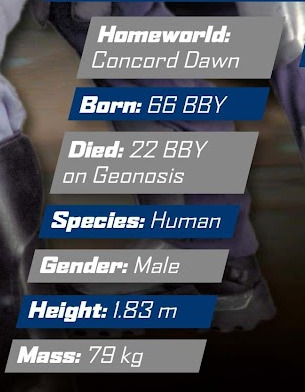
[1] the date for Battle of Galidraan is actually not that clear, as comics issue#3 places it “twelve years before Geonosis” which would mean 34BBY and Jango being 32. However Fact Files vol.3 #14 states “Fett led the Mandalorians for eight years, during which the hunt for Vizsla was never far from their minds”. Similarly, the comics too imply that between Korda VI and Galidraan eight years has passed (Silas said “twenty years ago” for events of Korda, Galidraan was supposedly be “twelve years ago” however comics used Geonosis as reference point, instead of 32BBY - the date the “present” story takes place, as Dooku’s memory about Galidraan was told in that year. Otherwise there would be little time for Jango to gain a reputation as Bounty Hunter, as he said in the same comics (issue #4) “I rotted on spice transport for years.” - the plural form means at least two years, so he would be freshly out of slavery. The lore usually places Galidraan in 44BBY so I prioritize the eight years between Korda VI and Galidraan over comics flawed calculation.
The collected data allows us to establish that Jango was:
8 years old during attack on his family on Concord Dawn
14 years old when Jaster died on Korda VI and Fett became leader of True Mandalorians
22 years old when his True Mandaloris were killed by Jedi on Galidraan and he was sold into slavery
34 years old when became DNA donor and father of Boba
44 years old when killed
There is a little well-documented chronology for Walon Vau. From the bits of information, we can established that
Walon run away from his biological family at young age
“That strill had stood by him since boyhood” [Republic Commando: True Colors]
and
“Mird has been with me since I joined the Mandalorians” [Republic Commando: Triple Zero]
or
"Vau," he said carefully, "is still a fit man. A soldier since childhood, just like you and like Kal'buir. [Republic Commando: Triple Zero]
Of course, Vau joining Mandalorians does not necessarily mean joining right away True Mandalorians.
he was part of Jango’s True Mandalorians at least just before Galidraan
Vau didn’t meet Skirata’s eyes for a moment, but he glanced at Jusik. “I could have been at Galidraan, but I wasn’t, and I never forgot that. Not my fight. Should have been my fight.” [Republic Commando: Order 66]
So Vau knows Jango at least for 22 years (since 44BBY to 22BBY, the start of Clone Wars) however depending on interpretation, True Colors may implies, Walon could recall Jango’s undernourished appearance as a youngster:
Vau looked at Mereel in profile and tried to see Jango in him, but it was surprisingly hard. Odd as that might have sounded to an outsider, it was true: the clones usually didn't remind him of Jango Fett at all. Part of that was living among them for years, and becoming blind to the superficiality of appearance, but there were many ways in which they didn't even look like their progenitor. Jango - born of parents who lived hand-to-mouth, undernourished as a youngster - hadn't been much taller than Skirata, but the Kaminoans had managed the clones' nutrition carefully from the day the egg was fertilized, and they'd turned out tall and muscular. In a hundred and more ways, they weren't exact replicas of Fett.
From vocabulary.com:
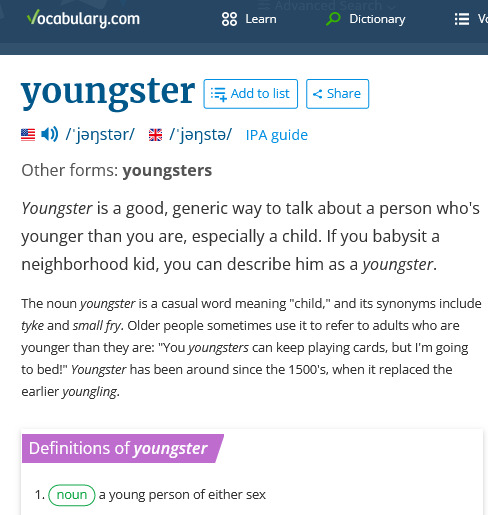
Youngster is a good, generic way to talk about a person who's younger than you are, especially a child.
Jango in 44BBY was 22 years old, and Mandalorian for 14 years, so it is possible that due proper training he gained appropriate body weight and was better nourished - if Walon knew Jango only as an adult man, would he had so hard time to see Jango in clones he trained since they were two years old?
For a better picturing this matter, below a reaction of people who knew Jango only as an adult man and already met a clone troopers:
Attack of the Clones by R. A. Salvatore
Jango Fett walked in, dressed in simple shirt and trousers. Obi-Wan recognized him immediately, though he was many years older than the oldest clone, his face scarred and pitted, and unshaven. His body had thickened with age, but he was still physically imposing, much like many of the old gutter dwellers Obi-Wan encountered in far-flung places. A few extra pounds, sure, but those covered muscles hardened by years of tough living. Tattoos crossed both of Jango's muscular forearms, of a strange design that Obi-Wan did not recognize.
The Cestus Deception by Steven Barnes:
If Obi-Wan was entirely honest with himself, he had to admit that large groups of clone troopers made him slightly uncomfortable. Easy to understand and explain away. One factor was the fact that they were the absolute image of the notorious bounty hunter Jango Fett, who had come within a hair of killing him on three separate occasions. More disturbing still was the fact that, although genetically human, they had not led human lives: clone troopers were born and bred purely for war, without the nurturance of a mother's embrace, or the safety of a father's loving discipline.
or
As he came out of his thoughts, again he had the sense that she was staring at him, and this time he felt uncomfortable. "Why do you look at me that way?"
She shook her head. Then, as if she thought herself the biggest fool in the galaxy, she shook with peals of deep, rich laughter. "I suppose I keep expecting you to remember me. That's crazy, of course." She laughed again, and Nate just felt more confused.
"You have to pardon me."
"I don't understand."
"I suppose I should have told you before. I knew Jango Fett."
He didn't quite believe what he'd heard. Worse, he wasn't sure how to react. "You did?"
She nodded. "Yes, twenty years ago, in quite another life. Seeing you was kind of a shock. When you took those helmets off-wow!" Her laugh was throaty and vibrant. "It's him, all right, and just about the age he was when we first met."
Nate's head spun. "I should have expected that, I suppose. Certainly some of my brothers have also encountered people who had known him ... I've just never spoken to one."
As Walon said, living among clones for years made him blind to the superficiality of appearance, but I think it is safe to assume Vau knew Jango for longer than the established minimum of 22 years.
There is no proper date of Walon’s birth, however the books either mentioned he is past his prime
Boss stands his ground. "You can't carry it all on your own."
"I can carry enough." I can haul a fifty-kilo pack all right, maybe not as easily as young men like them, but I'm motivated and that shaves years off my age. [Republic Commando: True Colors]
or Walon is outright called an old man, both by himself or other characters:
"You're conspicuous in that black armor, Sarge," Scorch said kindly. "It's worse than having Omega alongside. What say you back out of here and leave me to hold them?"
If anyone was going to do any holding, it was Vau. "Humor an old man." He fumbled in his belt for an EMP grenade. "I stop the droids, you pick off the wets." Wets. Organics. He was talking like Omega now. "Then we all run for it. Deal?" [Republic Commando: True Colors]
or
"Walon, whatever we've said or done to each other before this moment, it doesn't matter. Cm vhetin. A fresh field of snow."
Vau looked at him blankly for a moment. Maybe he knew how precariously Skirata balanced on the edge of his resources right then, but that craggy humorless face softened for a few telling seconds.
"Cin vhetin." Vau grasped Skirata's arm in a vise-like grip. "Mhi vode an, ner vod."
Vau seemed purged. He slapped his thigh plate, and Mird trotted after him into the galley.
"Sorry about that, Bard'ika," Skirata said. It couldn't have been easy for the kid to hear all that bad blood about Jedi on this particular night. He might have turned his back on them and put on the beskar'gam, but they'd been his family, and some of those killed must have been his friends. Jedi were living beings, too; some might have got what was coming to them, but others were probably decent like Etain and Jusik. "We're tired old men, with tired old grudges."
or
Vau did his icy I-know-something-you-don't smile. "Sport-fishing isn't sport unless you run the risk of being caught yourself, is it?"
"There's always relaxing on the beach," said the Rek. "Or a pleasant walk around the harbor."
She seemed to have classed them as two old guys trying to rediscover their youth through destructive machismo, maybe with Mereel as the fit young minder who could haul them out of trouble. It was perfect: whoever Ko Sai had as a contact here-and she'd need one, if only to get hold of supplies- wouldn't be tipped off to the fact that Mandalorian bounty hunters were in town. [Republic Commando: True Colors]
or
"Someone has to pilot Aay'han, because those things won't have much range," Vau said. "And I'm volunteering. I had my midlife crisis about ten years ago, so you can go play boy racer this time, Kal..." [Republic Commando: True Colors]
Additionally Commentary:
The definition of a midlife crisis is a period of transition in life where someone struggles with their identity and self-confidence. It happens anywhere from 40 years old to 60 years old and affects men and women. A midlife crisis is not a disorder but is mainly psychological. It occurs when someone looks at where they are in life compared to where they think they should be by a certain age.
Who is affected by a midlife crisis?
Men and women can both experience a midlife crisis, but it may look different for each. On average, most people experience one between the ages of 40 and 60 years old, but you may have it before or after those ages, as well. [From acendahealth.org]
As True Colors takes place in the second year of Clone Wars - if Vau’s words were meant to be interpreted as fact - the midlife crisis would happen around second year on Kamino. Of course, Vau may be sarcastic here but he could also mistake depression for the psychological crisis as the book series often pointed out how time spent on Kamino was depressive for Mandalorian training instructors and Vau was no less affected by that. This actually can be supported by the same book:
Scorch is about twelve years old. He's also twenty-four, measured in how far along that path to death he actually is, which is the only definition I care about. He's running out of time faster than me. The Kaminoans designed the Republic's clone commandos to age fast, and when I think of them as the tiny kids I first knew, it's heartbreaking-yes, even for me. My father didn't quite kill the last bit of feeling in me.
Side note: if I calculate right, the clone commando training started in the second year (8 years before Geonosis, as around that time Kal Skirata showed up on Kamino and was soon to start training clone cadets. Logically, each batch should start their training at the same time, so the “midlife crisis” could easily happen when Vau started training too young children for Republic and Jedi as this challenged both morality and principles of Mandalorian culture.
Kal Skirata was said to be around 60 years old [RC: Order 66] and book series keep describing him and Walon as “old men”, so it is easy to assume the age difference between Jango and Walon was quite significant, most likely more than a decade. Depending when Walon joined True Mandalorians - before or after Jaster Mereel’s death - there is also a possibility he could help train Jango when Fett was still a cadet or at least knew him (if not just heard about him), as Jaster Mereel had a special spot for the kid:
Jango Fett: Open Seasons, issue #2:

Jaster Mereel: Make me proud, Jango.
Jango Fett: Yes sir, Jaster.
Montross: I think he sometimes forgets that you're not really his son. Hnh. That's dangerous. Clouds his judgment. And yours. [...]
Fact Files vol. 3 #14:

"Jango became a favorite of Jaster Mereel, something that didn't sit well with one of his men, Montross [...]"
Additional Commentary: It makes sense to think that older and/or more experience Mandalorian Mercs helped to train the cadets however it is worth to keep in mind that Walon Vau was introduced into story as specialist of interrogation and True Mandalorians in fact trained their members to endure tortures [Jango Fett: Open Seasons, issue #2]. This information comes from Silas, who was part of True Mandalorian first under Jaster Mereel's and later Jango's leadership. It is hard to tell when and how interrogation became Walon’s expertise, but if he took part in training of cadets, his training may as well be pretty brutal to endure. On another hand, if Jango spent eight years keeping the hunt for Vizsla in mind all the time, Vau could be one of the people responsible for gathering information about Death Watch from captured enemy soldiers or other suspects. If he was that good as books implied he was, this could make him a valuable addition to Fett’s army.
CHILDHOOD TRAUMA
[Prime source] Jango Fett: Open Seasons, issue #1
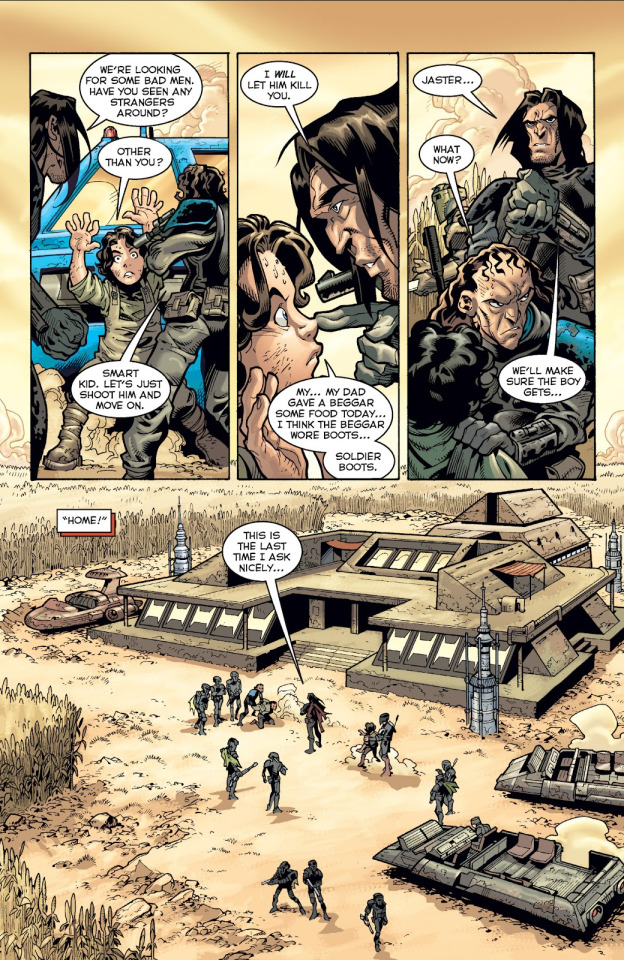
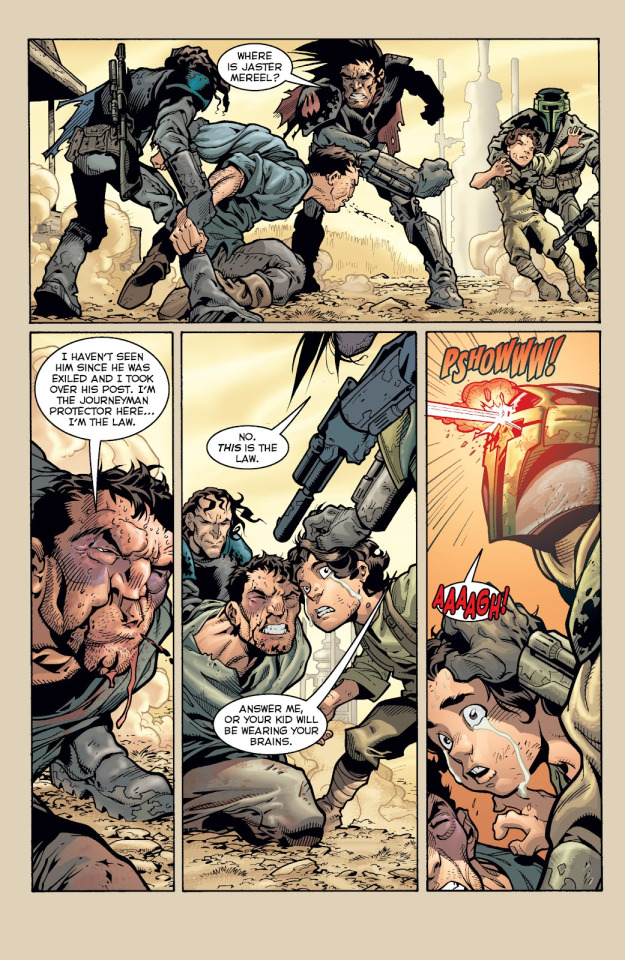

Imperial Commando: 501st
Jusik didn't know what to expect; he just knew that she'd been hurt, physically and emotionally. Jango had told Vau just the barest detail about the Death Watch punishing his father for harboring Jaster Mereel, and his mother shooting one of them dead so Jango-eight, maybe-could get away. That was the last he saw of all of them, his mother shielding fourteen-year-old Arla, his father on his knees yelling at him to run.
Jango thought they'd all died.
Additional Commentary: For a supposedly the barest detail, the short description accurately presents what happened in original source [“Death Watch punishing his father for harboring Jaster Mereel”; “his mother shooting one of them dead” “his mother shielding fourteen-year-old Arla”, “his father on his knees yelling at him to run”], so maybe it is not Vau who get the simplified version from Jango, but Jusik from Walon?
For better contrast, below a story Jango told Zam Wesell:
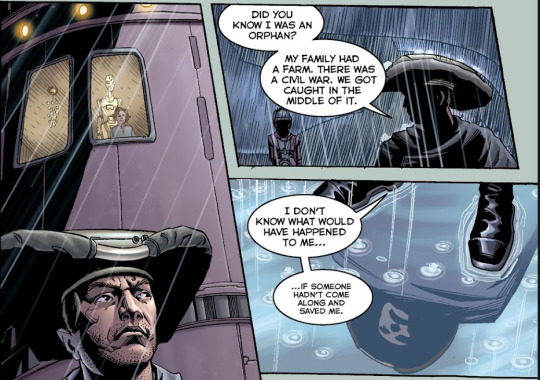
"Did you know I was an orphan? My family had a farm. There was a civil war. We got caught in the middle of it. I don't know what would have happened to me... if someone hadn't come along and saved me" [Source: Zam Wesell comics, 2002]
Additional Sources: Jusik and Kal Skirata were aware that Jango Fett had a sister in previous book (RC: Order 66), as this was their main motivation to abduct met by accident Arla Fett from the asylum:
"I thought I was a chancer," Skirata said "but Bard'ika, you make me look like a Neimoidian accountant. You know who that is, don't you? If she is who she thinks she is, anyway. Because she's supposed to be dead."
"Oh, I know," Jusik said. In the last few years, he'd absorbed all he could about Mandalore and its people, both from Mando'ade themselves and from aruetiise who knew them all too well-like certain Jedi. "And that's why she deserves our help."
"So who is it?" Vau asked plainly irritated. Mird watched the woman with head cocked tail slapping. "We'd better have a good reason for taking a psychotic killer with us tonight."
"We have," said Jusik. "That's Arla Fett-Jango's missing sister."
In the same book, Fenn Shysa also seems to be aware about the fate of Jango’s biological family:
Shysa was making an awfully big assumption about Boba's willingness to take over where his dad left off.
"Fett's got an older sister, you know. Arla."
"No, Vizsla killed them all."
"Not all."
"Now you tell me. Are you having me on, Kal?"
"No, ori'haat. I swear. Jango thought they all died, but the girl survived somehow [...].
It makes sense that Mandalorians, especially the survivors of True Mandalorians (and Jusik who learned from them) to some degree were familiar with their leader's past, however their knowledge doesn’t necessarily need to come from Jango himself.
Additional sources outright say or strongly implies Jango wasn’t willing to confide in others about his childhood trauma.
Internal memo penned by Hali Ke, senior research geneticist, Kamino, 27 BBY (source)
I have now logged many sessions with our prime clone Jango Fett, and concluded that he embodies his species’ contradictions. He is a killer many times over, ending the life of others without hesitation if paid to do so, yet his anger was obvious when I suggested he lacked morality. He is one of the most able, competent humans I have ever observed, remaining calm in situations that would leave most organics helpless with terror. Yet he witnessed horrors in his childhood that he will not discuss, and around which his mind has constructed apparently impenetrable barriers.
Jango Fett: Open Seasons, issue #2

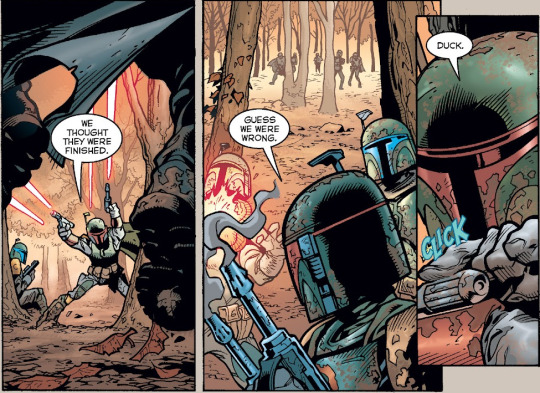
Important thing to note: Jango only described the enemy as “ex Mandalorians who split with Jaster Mereel years ago” instead of personal information like killers of his biological family. It could be due to being under enemy fire, however the fact that Silas has no clue who Death Watch was in the first place, strongly suggests that Jango did not mention his childhood trauma in any specific detail to him, while comics presented Silas as deeply loyal to Jango, both as first person to stand by him against Montross’ claim to leadership

and as a man who endured for a whole year a torture because he refused betray Jango and who used his last breath to ask Dooku (the torturer) to not tell Jango about his failure.
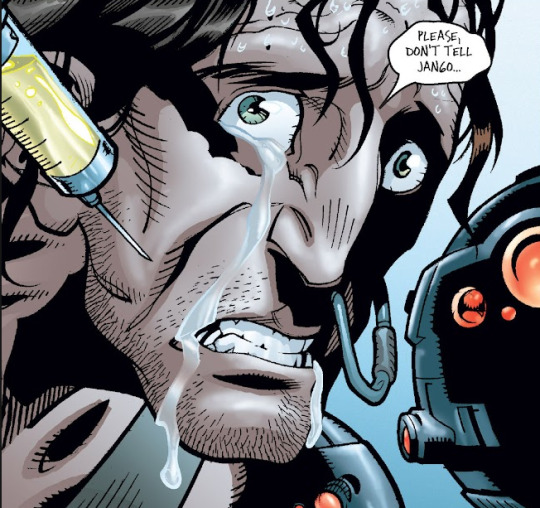
As Imperial Commando: 501st states, “Jango had told Vau” about his childhood trauma and there is no reason to think Vau lied about this to Jusik. So far, within the broadly understood Republic Commando series, Walon is the only mentioned character to whom Jango voluntarily confided about things he normally did not speak.
(Unless, as pointed in my additional commentary for Age Difference, Vau did in fact trained Jango to endure torture and he managed to break Fett to get this information from him during "exercise" while he simply omitted that detail when sharing his knowledge about Jango's childhood with Jusik. Personally I like more the implication of trust given to Vau what fits well with his role in Kamino program, however I feel obligated to mention this possibility as another interpretation.)
However when it comes to Vau’s own biological family and his aristocratic title, Republic Commando: True Colors says Kal Skirata was most likely the only person he told about before Clone Wars.
"What's in there, Sarge?"
I'm not robbing for gain. I'm not a greedy man. I just want justice. See? My Mandalorian armor's black-black, the traditional color of justice. Beskar'gam colors almost always have meaning. Every Mando who sees me understands my mission in life right away.
"Part of my inheritance," I say. "Father and I didn't agree on my career plans."
Justice for me; justice for the clone troops, used up and thrown away like flimsi napkins.
"The drinks are on you, then," says Boss, Delta's sergeant "If we'd known you were loaded, we'd have hit you up earlier."
"Was loaded. Cut off without a tin cred."
I've never told them about my family or my title. I think the only person I told was Kal, and then I got the full blast of his class-war rhetoric.
Additionally commentary: Once Walon and Kal joined their forces to provide clones a future outside the army, Vau started to mention his aristocratic family more often (sometimes simply to annoy Skirata). This of course does not cross out the possibility that Jango wasn't privy to this "secret", as Fett could easily learn that from other Mandalorians, like his mentor Jaster Mereel (if Walon already was one of his True Mandalorians while Jango was a young cadet himself), or even straight from Kal who was passionate about the topic enough to lecture Walon - something that was mentioned through the books on few different occasions and these two men knew each other for decades.
Republic Commando: Triple Zero
"Yes, we all know." Vau turned to Etain. "This is normally where he starts lecturing me on his ghastly childhood as a starving war orphan living feral on some bomb site, and how I just ran away to become a mercenary because I was bored with my idle, rich family."
"Well, that saved me some time," Skirata said irritably. "What he said."
Thus it is up to debate, if Jango knew and if he knew then how he learned that and if he didn’t, why Walon did not mention it at all. There are potential possibilities like that Jango simply wasn’t interested in Vau’s past so he has never asked (the other, out-of-universe explaination is that the author did not had at that time outlined the plot-twist about Jango and Walon’s much closer relationship than Jango and Kal - the main character of book series since Triple Zero. This is the most likely the case, as Karen Traviss’ Legacy of the Force books that predate Order 66 pretty much ignore Jango & Walon relationship in favor of Jango and Kal mentions in Boba’s POV characters. But about that more later.)
[Next part coming hopeful soon]
#star wars#jango fett#walon vau#jango fett and walon vau#cienie's research#so far a) vau knows stuff jango wasn't willing to share#b) likely knew him as youngster#c) likely the age gap is quite bid maybe even more than decade#if jango was mereel's favorite (and treated as son) probably everyone who served back then knew or heard about the kid#as the boss' kid so who knows maybe vau and other older than jango mandalorians babysitted him lol just a thought#i should write about galidraan and related matters as next part but we will see if i will go with proper chronology or skip straight#to kamino era#sorry for bringing so much skirtata but he is the main character since Triple Zero and a lot stuff orbiting about him and his men#gives some good insight into jango and walon
34 notes
·
View notes
Text
May the Forth Be With You - Star Wars in TWST
Mostly my world building ramblings lol
Please remember these are just all funky little headcanons and some (many) are prone to change!!
For starters, the Academy for Force Adept Individuals (that name is a wip lmao) has a much smaller student pool than the other "magic" schools, and as a result is a school not restricted to only boys, especially seeing as some species that are among the student body do not have definitive male or female distinctions. There isn't a definitive "dark" or "light" side- Force is merely referred to as a tool or energy, and not a "power". We know that NRC has kind of murky morals as it is, and RSA would stand to have a very strong moral view in contrast. This is why in a smaller school, with beings from all over (the interstellar "neighbourhood") it's difficult to try and teach one "way" or another, so the students are taught from as unbiased a standpoint as possible, as for most subjects that do not require the use of the force, droids have been employed to teach.
NOT basing this on the Old Republic, otherwise they would have had to have been taken in before the age of 13 as a padawan. They are still about 16-19 years old- transferring in from another academy somewhere else. The academy in TWST is a melting pot, and provides a good opportunity for students to learn more about the customs of those from around the galaxy and make (hopefully) lifelong friends. Along with your typical school subjects (history, sciences, maths, and language study of some sort) there are classes for agriculture, medicine and "survival"- reflective of the Agricultural Corps, Medical Corps, and Exploration Corps- to establish the basics in each, in case students are not selected as a padawan or they choose to get a job in one of those areas rather than serving as a Knight. (Force Knight- no light/dark connotations.)
There are elective classes for those as well ^^ for anyone who needs/wants extra credit in the main class or who just want as much practice as they can get in before going into the field they hope to pursue.
Other than those three ^ the rest of the electives also have clubs, as many classes overlap that specialize in certain skills Force users are being taught, but still provide the opportunity for them to learn, as well for upperclassmen to have a chance to tutor the newbies a little bit and give them experience in a leadership position (while still being supervised to avoid conflict)
A lot of the time, the clubs aren't directly related to the elective For example if the elective class is about how to change probability or to increase luck, many of those students enter the board game club However, playing against students that have mind reading as an elective, makes the game a little more fair But then there are students who also have been learning to shroud their presence using the Force, and can do the same for their thoughts, adding yet another element of difficulty. Yes there are classes that utilize their lightsabers and reinforce/ teach them correct form, but then there are electives for specializing and studying multiple forms.
P.E is mostly about building the physical strength and stamina needed to serve as a Knight- and I'm thinking that Force Knights tend to be more of a sentry, I don't think trying to cram a whole ass war is going to work for this. However there are also duels that rely solely on the Force.
Force users tend to be feared in TWST as they 1. are a relatively new 'magic' to really be 'discovered'/explained by other species in Twisted Wonderland, and 2. don't accumulate blot. Some people don't believe they really exist, the idea of midi-chlorians and people being able to manipulate them beyond their scope of understanding.
The Academy is located on one of the other islands in the Land of Dawning, isolated for the safety of the students, but recently started participating in SDC and magift/spelldrive competitions.
That's all for now dslfkjhsdlkfj come back tomorrow for more SW posting for twst lmao
#v talks#twst#twisted wonderland#twst hcs#twst headcanons#twst scenarios#twst world building#twst star wars#may the fourth be with you
8 notes
·
View notes
Text


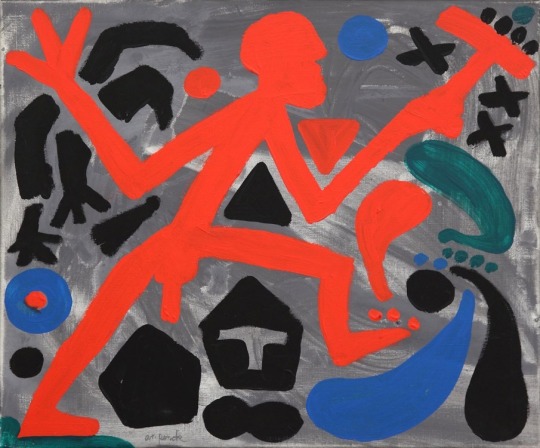


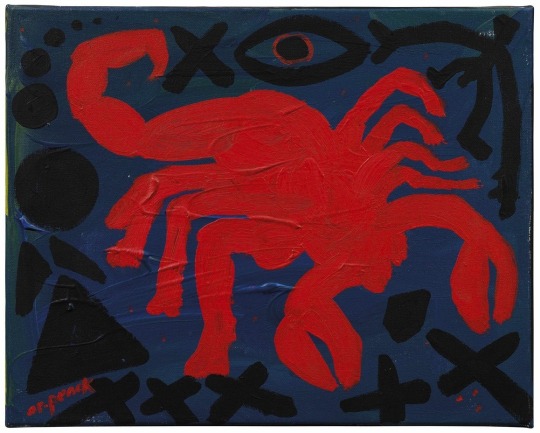


Ralf Winkler, better known as AR Penck (1939 - 2017, German), claimed never to have heard of conceptualism at the start of his five-decade career. Despite this, the German artist’s early Standart body of work, developed in isolation behind the Berlin Wall during the late 1960s, chimed with the emerging avant-garde tendencies of his western contemporaries. Like Lawrence Wiener and Joseph Kosuth, Penck, who has died aged 77, sought to develop a system uniting art and language that addressed complex sociopolitical themes; but unlike those American conceptualists, he did so using a primitive, almost childlike, imagery.
Paintings in the Standart series featured a rudimentary stick figure, a motif that would become central in his work. Blank-faced and stiff-bodied, they were often depicted with crudely drawn male genitals against an abstract background. A stick man dominates the frame of a 1971 painting, for example; daubed in black acrylic it stands against a riotous background of red circular splodges and rectangular markings. A couple of further primitive-style motifs interrupt the expressionist paint handling. An untitled work from 1968 shows a similar figure, stretched to appear almost comically thin. A circle, square, star and other symbols surround the human figure.
For Penck, the stick figure, though a motif that dates back to cave art, represented the first ideogram of a proposed new system of communication that combined text, symbol and image. Standart was a conflation of the English word “standard” and the German Standarte, meaning “banner”. For the artist, these works operated like flags, emblematic of human universality. Penck’s interest in networks, and a prescient desire for the unhindered flow of ideas between individuals, also led to an interest in early computer technology. A 1968 oil painting on board, titled Primitive Computer, proposed a new 45-symbol alphabet for the coming information age.
“Every Standart can be imitated and reproduced and can thus become the property of every individual,” Penck wrote in 1970. “What we have here is a true democratisation of art.” These paintings, and the accompanying sculptures, often made from discarded rubbish (as art supplies were scarce and often restricted in the German Democratic Republic), were smuggled to West Berlin, where they gained an immediate audience.
In his work Penck both embraced the utopian essence of socialism – he was one of the few of his peers to initially stay in East Berlin after construction of the wall in 1961 – while reflecting the harsh realities of the state’s authoritative regime. A work from 1969, painted on a blanket, depicts another crude figure in blue trapped within a bulkier counterpart in black. Simply titled Standart, it brings Penck’s creeping interest in existentialism and alienation to the fore, and it is perhaps natural that a cold war audience would find succour in allusions to claustrophobia and uniformity.
Continue reading https://www.theguardian.com/.../may/05/ar-penck-obituary
18 notes
·
View notes
Text
The Loss of Magic in Adaptations
I've noticed that in a lot of media (TV shows, movies, some books) it's such a popular trend to end the story by removing the magic or supernatural elements. Now in movies like HTTYD this is played as a separation for the betterment of both the magical (the dragons) and the normal, but they are still able to interact at times. Others, like BBC's Merlin, have the loss of magic as a tragedy or a consequence of the character's actions. Yet others, like LOTR, simply have it as a sign of a shift to a new age. All of these examples I don't have an issue with, the ones I do are when the loss of magic creates plot holes, messes up character arcs, and rewriting the world building. What I'm going to focus on in this post are the decision to remove magic and the supernatural from Game of Thrones and the Star Wars franchise.
The first example I'll give is Game of Thrones. The AOIAF books are full of magic, from glass candles to forest witches to ice zombies and dragons. In the adaptation, the show runners made the decision to remove most of the magical elements. This decision not only removes major plot points, it also takes away from the characters themselves. For example, Euron Greyjoy from the books possesses a dragon binder of Old Valyria, is going to Old Town to take the magic glass candles from the Citadel, and wants to bring about the apocalypse. In the show, since they took away the magical elements of his story, he is simply a man who wants power and a good fuck. He is completely undermined as a character and turned into an ineffective villain. Another example is the character Quaithe. She is a shadowbinder from Asshai who visits Daenerys through visions throughout the series and encourages her to visit Asshai. She has been set up as important to the future of Daenerys' character and her future with the dragons. In the show, however, she is reduced to saying a single line to Jorah in one episode about how Daenerys needs protection in Qarth. Speaking of Qarth, GOT completely removed Daenerys' prophetic visions in the House of the Undying, basically removing a major part of her Qarth storyline. These decisions among many others negatively impact the show and it was only done to appeal to "normal" people in the audience (ie, non fantasy nerds).
Star Wars is another franchise that suffers from some kind of distaste for supernatural elements. Star Wars is not usually thought of as a magical, but let's be real here, the Force functions as a magical system and it is a supernatural element, so I'm counting it. Dave Filoni has done a lot to pull SW back into the very supernatural story it was in the original and prequel trilogies, with the focus on the Force and Force-users in the Clone Wars, Rebels, and Ahsoka shows. However, this seems kind of pointless because of the sequel trilogy. I've done a post on this, where I basically said that the sequel trilogy makes the world building Filoni is doing kind of obsolete. I won't rehash that here, instead I'm going to talk about how the force itself is portrayed. At the time of the sequels, the Force has returned to turmoil despite Anakin's sacrifice. The Jedi are all but extinct and the sith are rising again. By the end, Rey has decided the Jedi must stay gone and the galaxy is left with a massive power vacuum after the fall of the New Republic and the First Order. The Jedi are meant to be protectors of the balance of the Force, clearly they lost sight of that during the Old Republic and Luke in the sequels has also failed. Yes, perhaps the Jedi as a name or religion should fall, but their ultimate goal is still proven to be necessary. Yet, there is no set up for a continuation of that goal; Finn is not training his abilities, nor does he seem to want to and Rey agrees the Jedi should be gone but there is no conversation about what should happen now. There is also a clear lack of the Force in the galaxy. In the original trilogy, this is explained by the Empire's efforts to take force sensitive children and turn them into Inquisitors as well as it's goal of suppressing powers that could oppose them. Yet there is no growth of the Force now that it is rebalanced and unsuppressed. It's fading, just like magic in stories like LOTR, but the Force is meant to be an all-encompassing thing that extends beyond just Force sensitive creatures. Therefore, making it so the Force is fading into obscurity is rewriting what is supposed to be a concrete truth of the franchise.
There are other examples of this desire to remove magic (and magic adjacent things) from media. Like taking the inherent magic surrounding the elves in Rings of Power and removing the elves and dwarves from the Eragon movie. There's nothing wrong with magic and the supernatural, especially when it's such an integral part of the story.
12 notes
·
View notes
Text
So this point might have been made but I would once again like to link the Death of the Clones and to the Fall of the Republic
We all knew that the downfall of the Republic went hand-in-hand with Order 66. In Clone Wars, Filoni, as we all knew, emphasized the clones’ death in the series finale as much as the Jedi’s in the movies. He places real emphasis on the effect it had on the clones, who we had grown to see as individuals, as people, while the Emperor saw them as a means to an end.
However, not only does Filoni acutely break our hearts by showing us the other side of the coin, he makes an interesting association throughout the show. The end of the Jedi means the end of the Republic, it’s true, but, in most media types, Luke Skywalker rebuilds the Jedi Order in a new way and helps preserve their legacy. The Empire is done away with and the Republic restored.
Or is it?
On one side, the New Republic and the Jedi show the resurrection of an old idea in new ways, a transformation in order to adapt to new ideals.
But the Old Republic is dead. The time of the Jedi intermeshed with the Republic is gone and buried, another story to be passed down as more of a cautionary tale than the height of an ancient order.
You know who else is dead? That never gets revived or reformed? The clones.
Our brave boys in every color under the sun die, and they never return, not in any way that prolongs them.
You see, they age on the double. During wartime, this was so they could get more troops on the field faster. Afterwards? It’s pretty convenient that they die twice as fast as the rest of the population. And even though surviving clones such as Rex and Wolffe and Gregor, the main ones we truly know about surviving later on at this point in the Star Wars Canon, made huge contributions to the Republic, it ultimately will not benefit them from a genetic or cultural standpoint.
Culturally, they were dead the moment the Emperor gave the order.
And, here’s the kicker, so was the Republic.
The Republic spent its last years mired in politics and war rooms and, as Filoni likes to remind us, clones.
I’m still going through my rewatch of the clone wars, but there are a few prominent scenes that come to mind that make Filoni’s point, intentioned or not, extremely clear.
The first is this gif of Commander Thorn’s death.

As Thorn falls back after his admittedly badass last stand, he lands in the center of what I would describe as a symbol of the Republic. The gear’s right there, formed by the droids.
This, of course, is just one of several moments where the Republic symbol is made, but it is a popular scene and a good example for the point I’m trying to make.
Thorn in this picture, takes the place of the Republic. And just as the clone dies, so, too, does the Republic.
Don’t believe me?
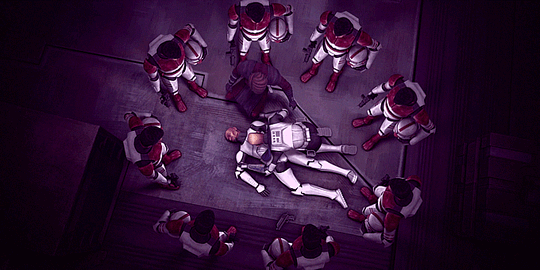
Fives very literally held the secret to the clones’s survival. And, as we all know, had the clones had full control, it is likely the Republic would not have fallen, or at least not as dramatically and without the multiple genocides on its way out.
Fives, in the gif above, is surrounded by the Republic symbol once again, only this time by other clones. It’s poetic, in a way, that two clones struggling to save their people die in a Republic symbol. Almost as if the fate of the Republic hinges on the fate of the clones.
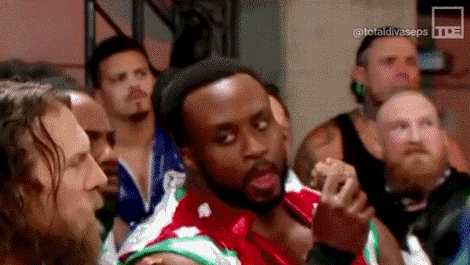
And if that doesn’t cover it enough for you, if you truly don’t see the connection between the clones and the Republic, I’d like you to meet a dear clone whom we all love:
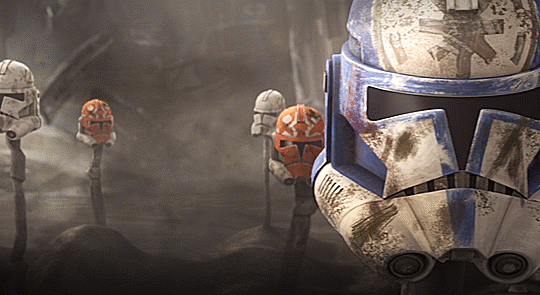
Jesse.
The only clone I’ve seen with a big ass tattoo of the Republic symbol stamped right there on his damn face.
Jesse, who truly believed in the Republic and had served long enough to be the only clone other than Rex to keep his helmet creatively apart after Ahsoka’s return.
Jesse, whose death marks the start of the Empire. His destruction and death under Order 66 marks the turning point in Clone Wars. Before they got the call on that ship, the Republic was alive and basically done with the war. But as soon as that ship crashed, as soon as we see that Jesse is well and truly dead, buried and respects and everything, the next scene, the very next scene, features Darth Vader and the Empire.
The clones were the canaries of the Republic. When they died, the Republic followed.
#thank you for coming to my TED talk#star wars#star wars rant#Has this point been made yet?#If it has then I salute you!!#And please direct me to the post#Also I am very aware that Kix technically lives for the next five decades#But his whole culture is basically wiped out at that point#star wars clone wars#commander thorn#arc trooper fives#arc trooper jesse#just yelling into the void#not shown: the clones giving me emotions#Your honor please#i connected the dots#i connected them#the fall of the Republic#clone death
25 notes
·
View notes
Text
on the prevalence of bounty hunters in the gffa
I’m not sure George Lucas intended bounty hunters to become as prominent as they are in the Star Wars universe. It might just be a consequence of Boba Fett Armour Rad ✨, like the invention of the Mandalorians. However, thinking about the Galactic Republic, it does make sense that there would be a lot of bounty hunters running around fulfilling a particular societal need.
The Galactic Republic’s structure is difficult to pin down because it doesn’t have a clear real world parallel. While it’s usually the United Nations or USA that are brought up, I suggest that its closest structural equivalent is the European Union; single currency, open boarders, high degree of internal autonomy while members are still meant to be bound by the laws and rulings of the higher courts and legislature, multitude of languages and cultures, states have the right cede unilaterally without requiring permission from the central authority. There are still differences though, and the one relevant to this discussion is that we aren’t shown a Republic equivalent of Europol, or the better-known Interpol. During the prequels era there are the Republic Judicial Forces and Jedi Order, but both these organisations provide specialist and crisis assistance rather than dealing with the day-to-day dealings of local planetary and system law enforcement systems. Nobody is calling the Jedi because someone skipped off-planet rather than front-up to court after crashing their speeder through a sixth-story window. Even if local law enforcement were inclined to do such a thing it wouldn’t be permissible, because the number of Jedi and Judicials is tiny compared to the overall population of the Republic.
I think the Republic logically should have an equivalent of Interpol, which I call the Intersector Security Bureau so it can keep its acronym when it is transformed into the Imperial Security Bureau. Given how easy it appears for anybody who owns a private starship to planet-hop undetected, facilitating information exchange must be hugely important. Still, the fact that so far as I can recall the ISB is never mentioned before the Republic becomes the Empire suggests that its reach is limited before Palpatine starts beefing it up. The Jedi do a lot of investigating but mostly rely on their own resources or liaise with the local planetary authorities.
There are a few reasons why an early ISB space!Interpol equivalent might have less prominence and reach than RL!Interpol. One is that it is affected by the same resources sap as the Judicial Forces; losing work to the Jedi Order and funding to local planetary or sector law enforcement. Another is that the Republic’s diverse array of species and cultures creates a complicated environment for hashing out the cultural consensus necessary for the level of understanding and trust required for agreeing to carry out other agencies’ arrest warrants. For example, the Republic’s de facto age of majority – the minimum age at which a person can hold Republic public office, like a become a Senator – is sixteen. This is not an age of majority that member systems of the Republic are required to adhere to in any way; having species with wildly different lifespans and lifecycles like wookiees, trandoshans, and ruurians makes trying to enforce a single age of majority a terrible idea. But that means that you have a planet like Naboo, where Padme Amidala can be employed in the political office of Princess of Theed when she is nine, under the same government as Alderaan, where the heir to the throne doesn’t step up into their full public role until they come of age at sixteen. Other points of difference – attitudes to gambling, recreational drug usage, corporal punishment, reasonable person tests, etc. – create a plethora of friction points between legal jurisdictions.
Then there’s the issue that many of the planets in the Republic aren’t going to trust the governments of every other planet in the Republic. RL!Interpol is facing controversy regarding the accusation that some countries like China have been submitting warrants for arrest on people who are actually political dissidents. In the Republic that translates to, for example, corporate-controlled planets putting out warrants on whistle-blowers calling out the companies’ fraud, environmental regulation violations, debt slavery, etc.
So, if you can’t rely on intersector law enforcement cooperation to retrieve your dangerous driver before any more speeders become wedged through the windows of high-rise apartments, what do you do? You put a bounty on them.
This implies that mainstream socially respectable bounty hunting is quite different from the “I can bring you in hot or I can bring you in cold” business the Mandalorians engage in. Reputable law enforcement agencies will only want their bounties hot and minimally injured; the idea is to get criminals back so they can be tried and punished in accordance with your law. And what if a bounty hunter screws up the bounty you posted and grabs the wrong person? If they’re alive you can stick them on a shuttle back to the planet they were kidnapped from, but if they’re dead that’s a PR nightmare and now you need to chase after that bounty hunter to charge them for murder.
Looking back a couple of millennia from the Post-Ruusan Republic to the Old Republic, many of these forces are still in play. One example of a deficit in law enforcement cooperation that I found particularly memorable was Miel Muwn of the Sullustan Constable Brigade from the Smuggler class story, who personally travelled to Coruscant in pursuit of the stolen Murustavan Ruby where he deputised two Very Upstanding Lawful Citizens to aid him rather than collaborate with the Coruscanti authorities.
Additionally, the division of the galaxy between the Republic and the Sith Empire creates another reason for those governments to work through bounty hunters. Because the Republic and the Empire are either in a state of hot or cold war, they obviously aren’t cooperating on issues like intergalactic crime. If either power wants to arrest someone who has fled into the other’s territories, the most legal least likely to spark violent conflict option available to them is to hire a third party (it’s still not very legal or unlikely to end in violence). Hence, bounty hunters everywhere.
…there are so many ways that this dysfunctional excuse for a system would produce bad outcomes.
#Meanwhile in a Galaxy Far Far Away#star wars meta#swtor meta#bounty hunters#the Galactic Republic#star wars prequels#star wars the old republic
59 notes
·
View notes
Text
The Clone Wars 2x14 ‘Duchess of Mandalore’ Reaction
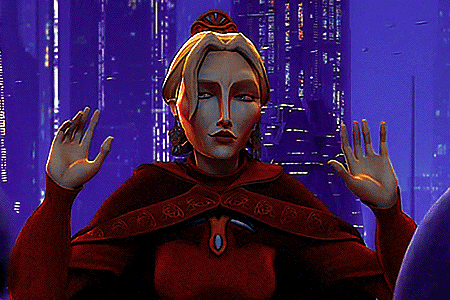
This first Mandalore-Obi-Wan/Satine-Obitine arc started out so well. 2x12 ‘The Mandalore Plot’ was an absolute hoot. One of my favourite episodes so far. 2x13 ‘Voyage of Temptation’ wasn’t quite at the same level but still had some fantastic and hilarious moments. And then everything just felt like it fell completely flat in the final episode of this Mandalore arc.
We’ve just been introduced to Satine, who we very quickly get to know as an exceptionally capable, hyper competent, dedicated and principled leader. She’s smart, shrewd, quick witted, intelligent, and has the nous to best Obi-Wan Kenobi, the Great Negotiator himself, whenever they flirt verbally joust. The Satine we know is there at the start of her appearance in the Senate, where she delivers the absolute banger of a line that is “You would trample our right to self-determination.”
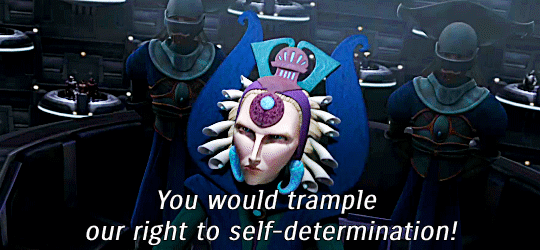
However it all goes downhill from there when the recording plays and she gets all flustered and upset. Now that is understandable given that she has the lives of her people at stake and she has just discovered that her deputy minister and supposedly good friend has betrayed her while in the middle of the Senate. Yet we’ve seen Satine maintain a level head and remain collected in the face of peril, threat and adversity before so why did she suddenly lose that composure in the Senate? It feels a little too much like leaning into the ‘women are too emotional to be leaders’ nonsense. Even with everything that’s happened, I really couldn’t understand this sudden 180 on Satine’s character. Also, a recording? Of course it’s fake. Though this is an audience perspective looking in, and there was no proof that it was doctored so of course Satine has to go off and find said proof. I did enjoy how much she was pissing off Palps though, and how much he couldn’t show it. Anytime that happens is deeply satisfying.
Then we get to Obi-Wan and Satine having their first real proper fight. The whole thing just seemed really unnecessary. I really was not impressed with Obi-Wan basically barging in with advice and telling her not to be hysterical. Sexist much? I guess this is one of those times where I have to remind myself that this episode aired over 13 years ago and so this is another example of how TCW has aged. Younger nerd me would still be pissed at that though so it doesn’t excuse it. Also, how is 2010 13 years ago?! I can see both of their points of view, even if Obi-Wan really didn’t go about delivering his in a considerate manner. In a way, they’re both right and they’re both wrong. Nothing good comes of it and then the Death Watch promptly tries to assassinate Satine, which gives you some idea of how well her day is going.
All the smarmy politics nonsense that happened after this was utterly frustrating. Hopefully that was the point because what else could that have been apart from an assassination attempt?! The speeder of a visiting political leader crashes into a building and that isn’t suspicious? I also really don’t like how the Republic thinks it can just march on over and decide what’s best for planets under the guise of helping. Sounds very colonial of them but then that’s probably the point. Just because the Republic might think they’re helping doesn’t mean they actually are. Especially when the people and elected leader of said planet have specifically stated multiple times that they don’t want them there. I can think of a lot of real world parallels that this is echoing. Another example of TCW tackling difficult, more nuanced topics. Though I’m beginning to realise that for all TCW is held up as fairly decent to good writing in Star Wars, there’s still plenty of ways that it also disappoints.
Satine has to find proof of the recording being doctored so of course she goes to the Coruscant underworld and of course her day gets even worse and she ends up framed for murder and is now a fugitive on the run. She’s got a hilarious unsubtle royal red hooded cloak on as a disguise, complete with ornate gold detailing. How is that fooling anyone? And then we had the chase sequence, which was utterly ridiculous. It was so laughably bad it reminded me of the speeder bike chase from The Book of Boba Fett.
I’m putting this tangent here immediately so that I don’t get hate for this. I want to make it completely clear that I enjoyed The Book of Boba Fett. There were some absolutely fantastic parts of the series. I think the highlight for me was the physicality Temuera Morrison brought to his acting and to Boba. He imbued so much of his Māori culture into Boba and You. Can. Tell. It was amazing. I loved it. There’s a video interview where he talks about this and I wish I could find it because it’s fantastic and definitely worth a watch. TLDR I enjoyed The Book of Boba Fett. Sometimes it feels like I’m one of the few who actually did. That said, I can completely recognise that there were quite a few elements of the show that were lacking, along with some decisions that were just ridiculous. Just because something is enjoyable doesn’t exempt it from critical thinking. Sidelining Boba in his own show and turning the back half of the season into The Mandalorian Season 2.5 was particularly grating. There were also parts of the show that unfortunately just didn’t land, and the speeder bike chase was one of them. It was supposed to be a speeder chase. That implies speed. The word is there in the name of the vehicles. Yet the whole thing looked like it was trundling along at about 20km/h, almost as if in slow motion. The chase sequence of Satine in this episode had the same vibes. It just seemed ridiculous. Everything happened so comically slowly. Clones are trained from birth and created with the sole purpose of being the perfect soldier and here they are bumbling around Coruscant like a pair of incompetent buddy cops from a dated British comedy show. There’s only so much you can suspend disbelief and it really didn’t feel believable that a pacifist royal could continue to evade a whole cavalcade of pursuers that included two highly trained genetically engineered soldiers and a Mandalorian Death Watch assassin.

Obi-Wan meeting up with Satine, at what I assume was the top of Umate, was also hilariously ridiculous. Two hooded figures in the most populous public space on Coruscant? That’s not suspicious at all! Though there might’ve been a little bit of an acknowledgment of this in Obi-Wan’s line “Nice disguise.” I did love the moment where Satine grabbed Obi-Wan by the front of his Jedi robes and dragged him away from where they were sitting. I’m realising more and more that it’s the little moments that really make the characters and the show. Also, these moments are often a lot more fleeting than I thought they’d be. There’s a similar one at the end of the show where Satine and Obi-Wan both look out over Coruscant through the window of the Chancellor’s office. I was expecting this to be a longer scene with conversation and a moment between the two of them. But instead it barely lasts a few seconds before the credits roll.
I will admit that Satine handing herself in as a distraction to allow Obi-Wan to get into the Senate building was particularly gutsy. So the episode is at least bookended by the Satine we know. I’m almost up to the next Mandalore arc in season 3 and it’ll be interesting to see how that goes. I also have so many episodes that I’ve watched and need to write about and Ahsoka comes out August 23 and I still have to get through seasons 3-7 of TCW and all of Rebels before that starts. Why have I done this to myself? *cries* I may have to revise my approach to these recaps again but I want to get through these ones first before I try changing things again.
#watching the clone wars for the first time#the clone wars#tcw#star wars#sw#star wars the clone wars#tcw 2x14#tcw 2x14 duchess of mandalore#satine#satine kryze#duchess satine#obi wan#obi wan kenobi#obi wan x satine#obitine#obi wan gifs#satine gifs#tcw gifs#mandalore#reaction
23 notes
·
View notes
Note
lena pls feel free to ignore this because it is very off topic but i don’t know any gamer gamers and i’ve seen you and other tumblr people talk about those games where you make choices and romance various aliens and do you have to shoot the video game gun good to play those?? my gaming skills are on the level of pokemon or nancy drew for example but i would like to kiss aliens too !!
Hi anon, it's no problem at all, I love to talk games! So I sort of separate the games I like to play out into two categories:
RPGs with choices
Choice-based games
"RPGs with choices" are what you've probably seen me talking about on here, like Bioware's Mass Effect (the one where you get to kiss aliens) and Dragon Age (the one where you get to kiss, like, elves and mages and etc.) or Spiders's Greedfall. These are some of my favorite games in existence, so I can't not urge people to play them as soon as humanly possible, because the stories, characters, and choices are absolutely fantastic; but these do contain real-time combat elements! So for Mass Effect, for example, you will need to aim and shoot things in between wooing your crewmates, and you do run around fighting enemies you encounter on missions. I'm not really good at shooting things, by any means, and you can play these on an easy difficulty, but if your level of comfort is more turn-based, this is something to know heading into it! Same goes for Dragon Age and Greedfall: you do have to fight things, but taking it slow and playing on the lowest difficulty might be less intimidating for you! Maybe look them up on YouTube to get a feel of the gameplay first!
Honorable mention here is BioWare's oldest game, Knights of the Old Republic, which is set in the Star Wars universe and features a kind of turn-based combat, though it takes some getting used to if you're used to things like Pokemon. However, there aren't really romance "options" (if you play a female character, for example, you have one male romance option, and if you play as a male, the reverse is true), and a brand-new remake was recently announced, so it might be worth waiting for that, since the old version does have some bugs unless you download some mods!
If turn-based games like Pokemon are more your speed, I'd recommend trying out games in my second category, which are more casual, typically more "choice-based," and not reliant on real-time combat at all. Among these are:
TellTale Games - all of the ones I've played from TellTale have featured excellent storytelling, and their gameplay style is all about making choices and investigating things via point-and-click (so I guess pretty similar to Nancy Drew), so there's no combat or anything like that (you do have to make some choices quickly, though). These feature less overt romance, though some titles do have it and let you choose between romantic interests for your character! I'd recommend their Walking Dead games or The Wolf Among Us to start out with!
Life is Strange - yes to romance options and yes to point-and-click gameplay! I definitely recommend starting with the original, which I believe just had a new remastered version come out. I haven't played Life is Strange 2 or Before the Storm (the prequel to the first game), but I also adored the latest entry in the series, Life is Strange: True Colors! However, like the TellTale games, these do have you play a set protagonist, not a customizable one where you get to choose your name and gender, etc.
Honorable mentions specifically for you:
Fire Emblem - if you haven't given the Fire Emblem series a try, I'd recommend it, particularly the latest and greatest entry, Fire Emblem: Three Houses! There are less choices to be made here (you get to choose what house you join in the latest one, which greatly diverges the story you experience, and things like who you want to spend time with; but there's less dialogue or story-altering choices like in the other games), and it features turn-based combat just like Pokemon. There are so many options to romance (and even matchmake between other characters as well!) in these titles that it will make your head spin. Gender-choice protagonists and the ability to romance/pair up characters started with Fire Emblem: Awakening, I'm pretty sure, so you could start with that one; Fire Emblem: Fates (not as good imo); or try out the most recent and richest title, Three Houses!
Persona - like Fire Emblem, this is not an actual "choice-based" game in the same sense of the others, but there is a large cast of romanceable options, a brilliant story and world, and turn-based combat very similar to Pokemon. And you do get to choose how to spend your time and make little dialogue choices, and there are different endings to each story as well! However, if playing as a female or male protagonist is important to you, only Persona 3 Portable has that option, and you'll have to wait to play that one when it's released on Steam on January 19th!
Honorable mentions in this category also include Supermassive's games like The Quarry and Until Dawn. These are horror-based games, though, but are all point-and-click choice-based games that do feature some romance/flirtation, though you switch between different (preset) character perspectives to help see these relationships through (or ruin them, it's up to you). Best played with other people for maximum effect!
Hopefully that helps you out, anon! And if anyone has any other suggestions to throw in there, feel free!
82 notes
·
View notes
Text
Got frustrated with Ahsoka today so have two things I would do to make her more interesting, feel free to take them an make fics and aus as long as credit is given:
Darksider Ahsoka - Consider that the whole warning during the Mortis arc is actually used and Ahsoka Falls, and she becomes a Terrifying opponent because she was trained by Vader, even if in his Anakin's era.
[More under cut]
She is a Menace as a Darksider, maybe keeping in the shadows and making every New Republic secret network Unsafe because she helped set them up as Fulcrum.
Worried about the Sequels? No problem! Secret Darksider Ahsoka! Everyone top level of the New Republic knows and is trying to Stop Her but Ahsoka was the Fulcrum, which meant Spying and staying undetected, she could totally do that to the New Republic where they can't do Anything to stop her
You could even bring Original Trilogy Group (Han Solo, Lando Clarissian, Luke Skywalker, Leia Organa, Chewbacca) back to act as the main heroes!
Want the Rebels back too? Have them as one of the people that Ahsoka is Playing and them slowly learning it and joining sides with the OT Group!
Also way to fix the live action lekku problem - too long would be impratical? Ahsoka VS Luke lightsaber fight, Luke LOSING Badly and someone grabs a saber - maybe Luke lost his or something - and cuts off Ahsoka's lekku's - saving Luke and resolving the problem.
You can have her Come Back to the light side but haver her Choices haunt her after
Mando contacts her because he needs help from a Jedi and he lost Luke's Number? She gives him Luke's number because She Can't help him, she doesn't consider herself a jedi even more and the republic won't allow her into any more battles in fear she will turn on them AGAIN
Maybe she is in fucking jail or Can't be put in a jail for whatever reason (maybe she came out as a Jedi survivor and explained everything she did to help the Rebellion to trap the New Republic Even More so they couldn't Act against her in public) so she is watched 24/7 - maybe by the Rebel Crew or Sabine for some reason (hence giving Sabine a reason to be with her and a whole nother stress for finding Ezra! because Ahsoka Can Not Leave Republic Space Or Enter Battles) and is trying to get back to being a Jedi, to clinging to the Lighside/Balance and trying to remember every single Jedi Philosophy she was taught
And also come to turns that Anakin wasn't the best Master for her, that he taught her somethings wrong that she will have to unlearn Alone and try to figure out how the Jedi taught it, what was the correct way to learn.
Because there are no more Prequel Jedi around to help her
Semi-Immortal Ahsoka - we all know that Star Wars media won't let people age - main example being the whole mess with Bo-Katan - and we know Filoni won't let Ahsoka die.
So! Since we know that, how about we take it and run with it?
Ahsoka who became semi-immortal because of being brought back by the Daughter so now she ages MUCH slower and will outlive EVERYONE SHE HAS LEFT THAT SHE CARES ABOUT, who will live to millions
If she doesn't die again that is
Because I'm thinking of like. A timer. That resets every time she dies
(you can take this further and say that she ends up back to the age of when the Daughter rescued her every time shed dies and maybe or not it takes longer every time for her to age past that age)
Ahsoka who learned the hard way how to be The Fulcrum via A Lot Of Deaths that earned her the rumour that she fakes her death A Lot to avoid taxes/jk
Ahsoka who grows afraid of getting the same attachment (as George Lucas Defined Attachment, not the common misconception you fools) problems as Anakin and adding in the fact that no matter what she does she will outlive people so she Stays Away from everyone even more because she doesn't want to go through the pain of losing people
so why get close in the first place?
#I will be honest#the last one is more out of irritation than anything#ahsoka tano#ahsoka#star wars ahsoka#mr talks#star wars#aus#ideas#mr ideas
7 notes
·
View notes
Text
Why Omega has a High M-Count
I suspect the reason why Omega has a much higher M-count than your typical clone trooper is because of her age rate is much slower than the clones.
Think about it, she and Boba are two of the only clones that have a normalish aging rate (not fully certain if they age slightly faster than non-cloned humans, but they are definitely slower than most clones), with Boba made to be Jango’s son as payment for being the clone donor, so the opportunity to check Boba for a high m-count would be unlikely.
Now, if the human body in Star Wars work roughly the same as real life, the cells either die or stop working with age. Keeping this in mind, because the average clone ages faster, the body also breaks down faster, thus decreasing or destroying the amount of midiclorian cells in the body.
If you want a good example of this, take a look at Yoda and Grogu. Their species are extremely high in midiclorians while living for HUNDREDS OF YEARS, and Grogu, who was around during order 66, is still a baby when the New Republic took over!
#dipstar1489#Star Wars#Bad Batch#Omega#Clone Wars#Boba Fett#Jango Fett#m-count#midiclorian#Yoda#grogu#the mandalorian#theory#“but hey that’s just a theory A FILM THEORY”
6 notes
·
View notes
Note
I love your AUs <3 I had not heard of the Venetocracy one before but it sounds super intriguing as well! Do you have any recommendations for books/shows/movies that have similar vibes? :) (Also, have you read Matomena Chomata by Dido Sotiriou?)
Similar to the Venetocracy AU? For all it's bad aging, I can't recommend the classic ballad Erotokritos enough. To me it's the pinnacle of chivalric love, and Aretousa's monologue refusing to marry anyone but Erotokritos and describing her nuptials with Death instead is just [chef's kiss]. Has me screaming every time! I also recently enjoyed the heist fantasy novel An Illusion of Thieves by Cate Glass, the subtle romantic subplot in that Italian Renaissance-inspired world is a whole mood.
I have started to compile a much longer list of what I call OC-adjacent media related to the 1920s AU, but as you said, it's mostly vibes, and some get extremely vague. I'll try and only give examples of content that is available in English translation, but Matomena Homata is one of them, which was translated to Farewell, Anatolia (I haven't gotten through Sotiriou's backlist yet, but so far it's been as lovely as it's been shocking). [tw for genocide, physical and sexual violence, war etc. apply for most of the recommendations]
Middlesex by Jeffrey Eugenides: The beginning of this in its entirety magnificent novel is probably the most striking account of the Catastrophe of Smyrna I have read. High-budget TV show when?
Birds Without Wings by Louis de Bernières: Idk why this Frenchman loves writing about Greek history so much, but I'll take it. This novel depicts the peaceful coexistence of cultures in Anatolia before nationalism took hold of Europe.
Little England (2013): Oh my god, my favourite movie... I'm sure the Picknick on Hanging Rock and Frantz girlies out there will understand. Andreas Konstantinou, main Alki hair inspiration, let me caress your nose.
Nyfes (2004): Perhaps more palatable to an anglophone audience (because less indie), and by the same director as the previous recommendation, this movie gives me the OC tingles each time.
Madonna in a Fur Coat by Sabahattin Ali: The best of pre-colapse Ottoman Empire and Weimar Republic combined, a lovely bit of classic Turkish fiction.
Poetry by Kostas Karyotakis: Get these vibes.
Titanic (1997): Yes, the Titanic. It's the drama, the class divide, the disaster for me. 5-year old me saw Billy Zane in Celine Dion's MV for "My Heart Will Go On" and thought I can fix him. So I did!
The Silence of Scheherazade by Defne Suman: WWI and its aftermath as experienced in Smyrna, told from Turkish, Greek and Armenian POVs. Another hard book to get through, read at your own discretion.
The Promise (2016): A historical the Armenian genocide starring Oscar Isaac. The sheer aesthetic of the absinthe-drinking hang-out scene... makes me lose my mind.
I haven't had the time to watch Smyrna, My Beloved and The Red River yet, but they are next on the list.
#answered#OC lore#my tbr is so long fml#may I also redirect you to my Erotokritos fanart#dm me for tw and the uh problematic content if you'd like to know
21 notes
·
View notes
Text
Star Wars – Saasa Raassiks
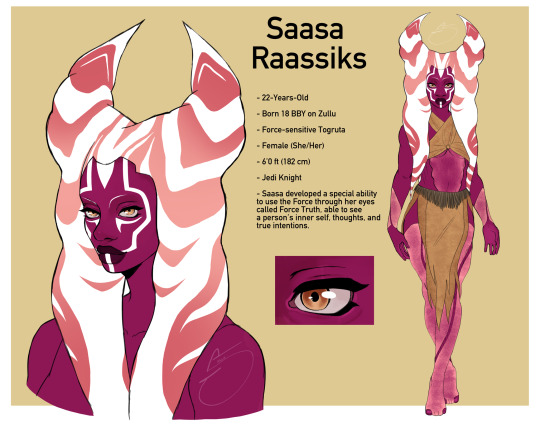
Saasa Raasskis is a 22-year-old Togruta female with Force sensitivity. She lives on the planet Zullu, which is uninhabited and serves as a living and breathing ecosystem for the Force. Her mother, Athsok Raasskis, was a former Jedi Master who fled Coruscant while pregnant during Order 66. Saasa was born and hidden on Zullu, where she was trained by her mother in the ways of the Force from an early age, however, Athsok renounced the conventional Jedi principles on account of their restrictive code, which, in her view, led to the Jedi Order's downfall. Due to the planet's unique conditions, Saasa has developed an exceptional connection and harmony with the Force, essential for her survival in the harsh environment. Athasok and Saasa lived in peace as Zullu wasn't recognized on many Star Systems to begin with, therefore the Galatic Empire had no knowledge of their existence. When Saasa was a child, she often felt lonely because she didn't have many opportunities to socialize with other people. Instead, she would spend long hours in the vast wilderness, where she made friends with the animals and even tried to use the Force to connect with others. Growing up in the jungle made Saasa a natural athlete, and she can effortlessly climb the dense terrain as if she were an animal herself.
In the year 4 ABY, just before the events of Return of the Jedi, Luke's ship crashes on Zullu after the Force summons him, causing his ship to be pulled towards the planet’s center. He survived for several days in the wilderness before Saasa appeared. Saasa was curious about the young human man and had been following him. However, she pretended to be hostile to protect herself and her home. Saasa developed a unique ability called "Force Truth", where she could use the Force in her eyes to look into people's inner selves, thoughts, and true intentions. After sensing that Luke was one with the Force and meant no harm, she apologized for her initial aggression towards him. Saasa then led Luke to her Mother, Athsok, who recognized him after hearing his surname. Athsok told him that she knew his father and Obi-wan, as they had all served together as generals of the Republic during the Clone Wars and all of the stories she had. Luke's desire to finish his Jedi training, as well as his natural curiosity about Zullu, led the mother-daughter duo to offer him an extended stay. They would teach him everything they knew, and he managed to remain on Zullu for a few months, learning how to survive on the planet by connecting to the Force.
Athsok, a highly skilled Jedi Master, was personally trained by the legendary Yoda himself. Her extensive knowledge and unparalleled experience in the Force proved to be of great assistance to Luke during his Jedi training. Through their rigorous training and survival in the unforgiving jungle, Saasa and Luke formed a strong connection through the Force, eventually leading to them falling deeply in love. However, their love was cut short as Luke was compelled to leave and rescue Han Solo on Tatooine. Despite this separation, Saasa made a bold decision to leave behind her mother and Zullu, and join Luke in his fight against the tyrannical Galactic Empire. Having spent her entire life in hiding, Saasa finally felt empowered to aid the Resistance in their struggle for freedom. Saasa showed unwavering trust in Luke's leadership during the events of Return of The Jedi and played a pivotal role in the destruction of the second Death Star's shield generator, effectively aiding Leia, Han, and Chewy to emerge victorious.
Luke and Saasa's relationship is a beautiful example of trust and mutual respect. Luke held Saasa in high regard for her plentiful knowledge of the Force and saw her as a mentor. Saasa, on the other hand, admired Luke for his compassionate nature and unwavering commitment to freedom. Together, they joined the Resistance and played a crucial role in defeating the Galactic Empire. When the war was over, Saasa decided to stay with Luke and his friends to work towards restoring peace throughout the galaxy. Over time, their bond strengthened, and they fell in love with each other. Eventually, they got married, and Saasa continued to support Luke as he rebuilt the Jedi Order with new, less restrictive codes. As a master, Luke established the order on Yavin 4 but later moved it to Zullu under Saasa's influence. They believed that living in harmony with the Force was the true way of the Jedi. Their love bore fruit in the form of a daughter named Paloa Skywalker, who was a human-Togruta hybrid. Luke and Saasa took great care in raising Paloa and instilled in her the values of the new Jedi Order. Together, they continued to work towards a better future for the galaxy with victories and failures, yet their legacy lived on long after they were gone.
(Note, I follow the continuity of Star Wars Legends and the Expanded Universe. I do not see the Sequel “Shit” Trilogy as a canon therefore my work will not include anything beyond Episodes 1-6.)
#star wars#luke skywalker#the empire strikes back#a new hope#return of the jedi#the phantom menace#attack of the clones#revenge of the sith#princess leia#leia organa#leia skywalker#han solo#han x leia#star wars anakin#star wars luke skywalker#star wars legends#star wars lore#star wars oc#star wars original character#star wars original trilogy#master yoda#mandalorian and grogu#tattoine#padme amidala#anakin and padme#obi wan kenobi#ben kenobi#togruta#ahsoka
4 notes
·
View notes